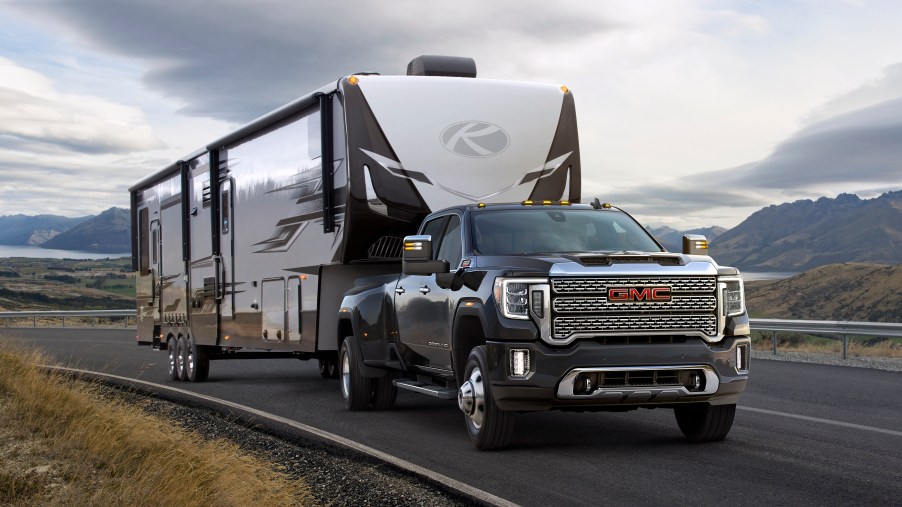
How Are Pickup Truck Tow Ratings Determined?
Up until fairly recently, no one understood how vehicle manufacturers determined their maximum tow ratings. Each manufacturer had its own private formula to determine the weight of the trailer that their vehicles could safely tow. Buyers had no way to compare these ratings among different vehicles.
In 2008, however, the Society of Automotive Engineers drafted a trailer tow rating standard, SAE J2807, and revised it in 2010. Toyota was the first carmaker to adopt this standard in 2013 and other manufacturers followed. This standard uses exacting real-world tests to calculate a maximum trailer weight rating. Thanks to this standard, buyers can compare a vehicle’s rating with any other that has also undergone J2807 testing.
Four categories of tests are used for this standard: acceleration, braking, handling, and highway gradeability. Jason Fenske of Engineering Explained took a closer look at these tests in his YouTube video.
Acceleration
In the video, a Ram 3500 4X4 truck equipped with a 6.7-liter inline six-cylinder Cummins turbodiesel engine was used for testing. The truck delivers 400 hp and 1,000 lb-ft of torque. It weighed 13,700 pounds and towed a trailer that weighed 30,645 pounds, making a combined weight of 39,840 pounds.
Acceleration is measured in segments for zero to 30 mph, zero to 60 mph, 40 to 60 mph, and a grade launch. Trucks with single rear wheels and those with dual rear wheels have separate criteria in the first three tests. The Ram passed all three.
For the grade launch, a truck sits on a 12% grade and is required to launch uphill five times within five minutes. After it launches it needs to travel five meters. This test simulates stop-and-go traffic on a steep hill. Its purpose is to ensure that the vehicle has no overheating or transmission problems while accelerating fully loaded up an extreme incline. In the video, the Ram performed the test on a 15% incline and passed it.
Braking
The first test of this category requires that the vehicle, along with its rated load, come to a complete stop from 20 mph to zero. The test is conducted with and without the trailer brakes activated. The truck and the trailer must also stay within an 11.5-ft track, which simulates a roadway.
It took the Ram more than twice the amount of time to brake without trailer brakes than with them. Fenske explained that, if trailer brakes aren’t used, more stress is put on the truck’s tires and only 34% of the combined weight of the truck and trailer reduces the truck’s speed.
The second test was the parking brake hold, which is performed while the truck is in neutral gear with the parking brake on. It must hold the combined weight of itself and the trailer on a 12% grade for both uphill and downhill inclines. The rear tires are supposed to prevent the truck and its whole load from moving. In the video, the Ram passed the test on the 15% incline.
Handling
SAE J2807 requires two handling tests for understeering and sway. Normally, understeering is undesirable in a vehicle’s handling. But this safety test uses understeering to reveal whether a truck can keep its trailer from whipping ahead of it while turning.
The truck is required to drive around the perimeter of a 300-foot circle. The amount of understeer needs to be increased to meet a certain range of lateral g-force as the truck moves in a circle. This means that, throughout the understeering, the truck’s rear tires need to maintain enough grip on the road surface to keep the trailer behind it. The Ram succeeded in completing this test.
Designed more for driver confidence rather than for accident avoidance, the sway test is run at a speed of 62 mph. The driver turns the steering wheel in a short sharp motion to determine the trailer’s movement relative to the truck. The trailer should recover quickly and not continue to sway.
Highway gradeability/Davis Dam test
Conditions at the Chelsea Proving Grounds in Michigan weren’t quite hot enough to replicate this test. It’s performed on an 11.4-mile strip of highway in the 100-plus degree heat near the Davis Dam at the Nevada-Arizona border. Additional requirements demand that the test use a grade that averages 5% with the truck running between 45 and 65 mph. Even with the truck operating at wide-open throttle, its air conditioning must be running at full blast using outside air.
The purpose of this demanding test is to find out how well the truck’s cooling system works while towing. To pass the test, the truck’s radiator can’t fail or show signs of imminent failure. But the Ram’s 1-meter-wide radiator, according to Fenske, could provide enough cooling to pass.
This battery of tests yields the most important number that meets the SAE J2807’s requirements: the trailer weight rating (TWR). It comes from subtracting the tow vehicle trailering weight (TVTW) from the gross combined weight rating (GCWR). The TWR is the number of pounds that a truck can safely tow according to meet the demands of the SAE J2807.


